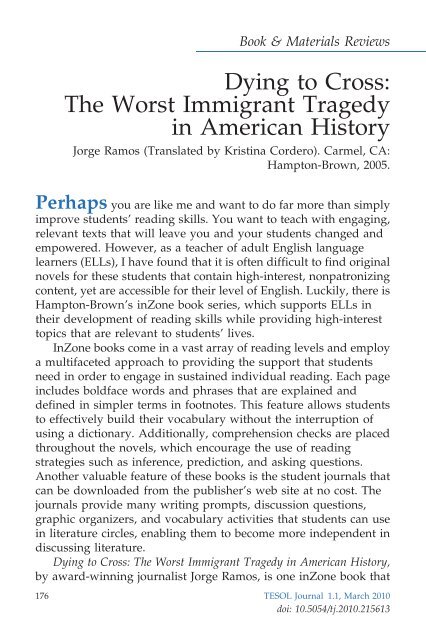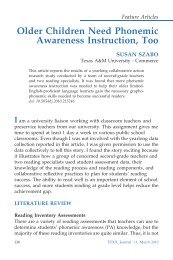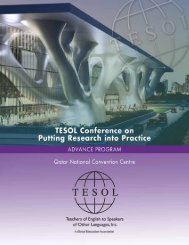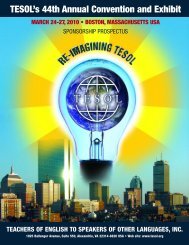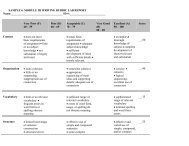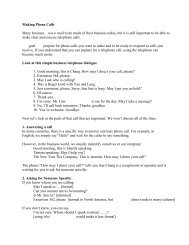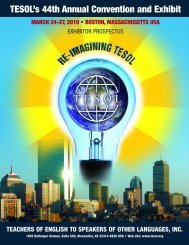Dying to Cross: The Worst Immigrant Tragedy in American History
Dying to Cross: The Worst Immigrant Tragedy in American History
Dying to Cross: The Worst Immigrant Tragedy in American History
You also want an ePaper? Increase the reach of your titles
YUMPU automatically turns print PDFs into web optimized ePapers that Google loves.
Book & Materials Reviews<strong>Dy<strong>in</strong>g</strong> <strong>to</strong> <strong>Cross</strong>:<strong>The</strong> <strong>Worst</strong> <strong>Immigrant</strong> <strong>Tragedy</strong><strong>in</strong> <strong>American</strong> His<strong>to</strong>ryJorge Ramos (Translated by Krist<strong>in</strong>a Cordero). Carmel, CA:Hamp<strong>to</strong>n-Brown, 2005.Perhaps you are like me and want <strong>to</strong> do far more than simplyimprove students’ read<strong>in</strong>g skills. You want <strong>to</strong> teach with engag<strong>in</strong>g,relevant texts that will leave you and your students changed andempowered. However, as a teacher of adult English languagelearners (ELLs), I have found that it is often difficult <strong>to</strong> f<strong>in</strong>d orig<strong>in</strong>alnovels for these students that conta<strong>in</strong> high-<strong>in</strong>terest, nonpatroniz<strong>in</strong>gcontent, yet are accessible for their level of English. Luckily, there isHamp<strong>to</strong>n-Brown’s <strong>in</strong>Zone book series, which supports ELLs <strong>in</strong>their development of read<strong>in</strong>g skills while provid<strong>in</strong>g high-<strong>in</strong>terest<strong>to</strong>pics that are relevant <strong>to</strong> students’ lives.InZone books come <strong>in</strong> a vast array of read<strong>in</strong>g levels and employa multifaceted approach <strong>to</strong> provid<strong>in</strong>g the support that studentsneed <strong>in</strong> order <strong>to</strong> engage <strong>in</strong> susta<strong>in</strong>ed <strong>in</strong>dividual read<strong>in</strong>g. Each page<strong>in</strong>cludes boldface words and phrases that are expla<strong>in</strong>ed anddef<strong>in</strong>ed <strong>in</strong> simpler terms <strong>in</strong> footnotes. This feature allows students<strong>to</strong> effectively build their vocabulary without the <strong>in</strong>terruption ofus<strong>in</strong>g a dictionary. Additionally, comprehension checks are placedthroughout the novels, which encourage the use of read<strong>in</strong>gstrategies such as <strong>in</strong>ference, prediction, and ask<strong>in</strong>g questions.Another valuable feature of these books is the student journals thatcan be downloaded from the publisher’s web site at no cost. <strong>The</strong>journals provide many writ<strong>in</strong>g prompts, discussion questions,graphic organizers, and vocabulary activities that students can use<strong>in</strong> literature circles, enabl<strong>in</strong>g them <strong>to</strong> become more <strong>in</strong>dependent <strong>in</strong>discuss<strong>in</strong>g literature.<strong>Dy<strong>in</strong>g</strong> <strong>to</strong> <strong>Cross</strong>: <strong>The</strong> <strong>Worst</strong> <strong>Immigrant</strong> <strong>Tragedy</strong> <strong>in</strong> <strong>American</strong> His<strong>to</strong>ry,by award-w<strong>in</strong>n<strong>in</strong>g journalist Jorge Ramos, is one <strong>in</strong>Zone book that176 TESOL Journal 1.1, March 2010doi: 10.5054/tj.2010.215613
proved <strong>to</strong> be quite effective <strong>in</strong> my college-level classroom. Most ofthe students I teach are immigrants <strong>to</strong> the United States and wereimmediately <strong>in</strong>terested <strong>in</strong> the retell<strong>in</strong>g of this true s<strong>to</strong>ry of a tragedythat claimed the lives of 19 Lat<strong>in</strong> <strong>American</strong> immigrants. Because theevent was widely publicized on Spanish-language television andoccurred <strong>in</strong> Texas <strong>in</strong> 2003, many students were already familiarwith some of the details and assisted <strong>in</strong> develop<strong>in</strong>g other groupmembers’ prior knowledge before read<strong>in</strong>g.Most immigrant students are extremely <strong>in</strong>terested <strong>in</strong> andpersonally connected <strong>to</strong> the <strong>to</strong>pic of immigration. As this bookexam<strong>in</strong>es the events that led <strong>to</strong> the tragedy, it also explores thevarious fac<strong>to</strong>rs at play <strong>in</strong> the operation of illegal immigration.<strong>The</strong> ideas presented by Ramos and the questions <strong>in</strong> the studentjournals facilitated deep critical th<strong>in</strong>k<strong>in</strong>g, and my studentsdiscussed and wrote about who should carry the blame for sucha tragedy: the governments of the Lat<strong>in</strong> <strong>American</strong> countries oforig<strong>in</strong>, the strict immigration policies of the United States,coyotes (immigrant smugglers), people <strong>in</strong> the United States whoexploit illegal immigrants <strong>in</strong> the labor market, the truck driver,or the victims themselves. Students further exam<strong>in</strong>ed why peopletake great risks <strong>to</strong> come <strong>to</strong> the United States and what might besome ways <strong>to</strong> prevent future tragedies like the one described <strong>in</strong>this book.Because of the high relevance of this issue <strong>to</strong> the immigrantstudents’ lives, they read critically, shared personal s<strong>to</strong>ries,exam<strong>in</strong>ed their own beliefs, and engaged <strong>in</strong> passionate discussions.After read<strong>in</strong>g the novel, one student wrote a composition relat<strong>in</strong>ghow she identified with the victims of the tragedy and how she wasnow more determ<strong>in</strong>ed <strong>to</strong> help those who, like she had been, weredesperate <strong>to</strong> come <strong>to</strong> the United States for a better life: ‘‘Whensomeone needs our help, remember, we can make the difference!Let’s demonstrate that we can do it and give a hand <strong>to</strong> whoeverneeds it <strong>in</strong> honor of all our brothers QUE MURIERON EN ELINTENTO (That were dy<strong>in</strong>g <strong>to</strong> cross).’’<strong>Dy<strong>in</strong>g</strong> <strong>to</strong> <strong>Cross</strong> is not for the teacher who simply wants <strong>to</strong> teachread<strong>in</strong>g skills and vocabulary development with<strong>in</strong> the protectedwalls of the classroom. It is for the teacher who dares <strong>to</strong> teachcritical th<strong>in</strong>k<strong>in</strong>g us<strong>in</strong>g a relevant, albeit political, social issue and isBook and Materials Reviews 177
not afraid of empower<strong>in</strong>g students <strong>to</strong> enter the dialogue <strong>in</strong> order <strong>to</strong>effect positive social change.Reviewed by Mary Amanda StewartUniversity of North TexasDen<strong>to</strong>n, Texas, United States178 TESOL Journal


